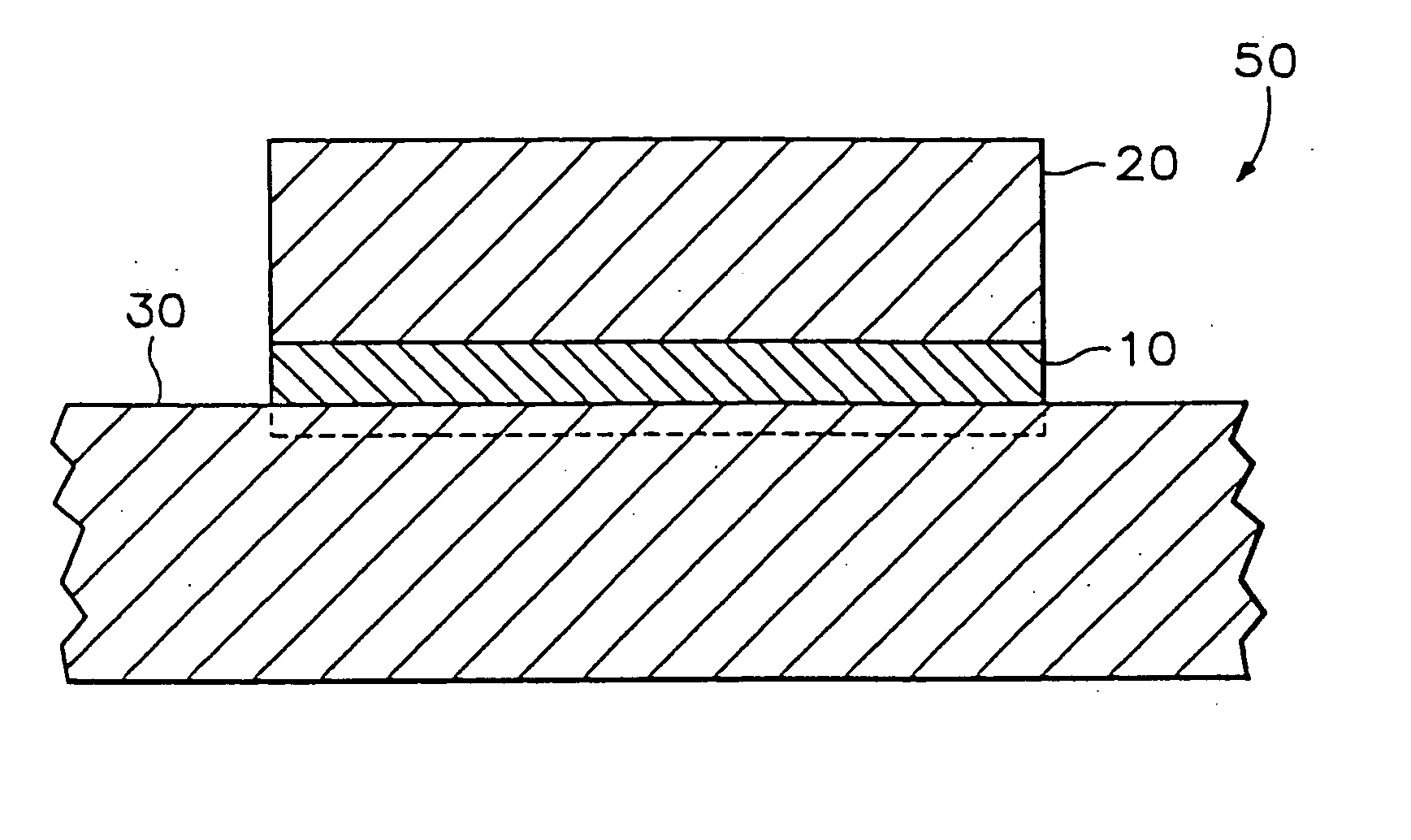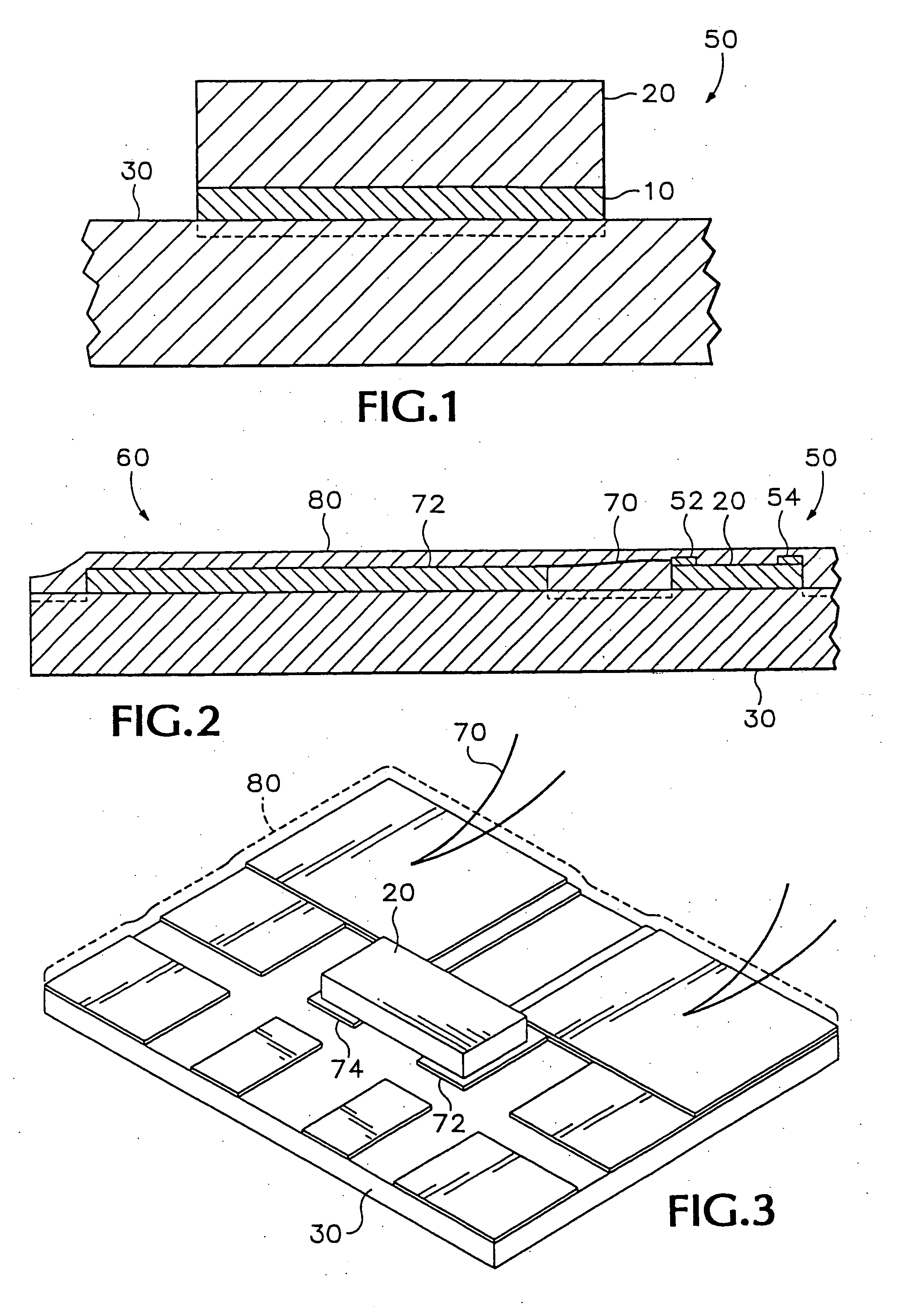Adhesion and/or encapsulation of silicon carbide-based semiconductor devices on ceramic substrates
a technology of silicon carbide and semiconductors, applied in semiconductor devices, semiconductor/solid-state device details, electrical apparatus, etc., can solve the problems of rapid temperature change, inability to deploy lateral sic devices (which require back-side electrical isolation) in high-temperature environments,
- Summary
- Abstract
- Description
- Claims
- Application Information
AI Technical Summary
Benefits of technology
Problems solved by technology
Method used
Image
Examples
example 1
[0062] As depicted in FIG. 1, a bonding material 10, comprising borosilicate glass (composition=30 to 50 weight % B2O3+70 to 50 weight % SiO2), was produced and was employed as a high temperature, shock immune adhesive to bond an SiC wafer 20 to AlN die 30. The resulting structure is a SiC semiconductor on ceramic substrate 50.
[0063] The bonding material 10 was initially composed of finely ground and mixed powders of: (a) unreacted constituent oxides, or (b) reacted mixture. The adhesive was applied to one of the bonding surfaces (preferably the bottom side of the SiC wafer) as a dry powder, but can also be applied in the form of a slurry. In slurry form, all vaporizable slurry constituents (e.g. water) should be baked off before performing the bonding process.
[0064] The surfaces to be bonded (at least one of them coated with the dried adhesive) were placed together, and shift pressure was applied. The process is thermally activated by transferring the assembly from ambient air to...
example 2
[0072] The protective attributes of the stable encapsulating layer of this invention were experimentally determined, as follows:
[0073] Referring now to FIG. 2, a portion of a tungsten (W) wire 70, which oxidizes easily, was connected to a metal bond pad 52 on an ohmic contact on the SiC chip and to the metal bond pad 72 on the AlN substrate. The assembly 50 as well as the wire 70 and pads 52, 54, 72 were then encapsulated within an encapsulating layer 80, on the AlN die 30, following the temperature ramping procedure described in Example 1. Then the encapsulated assembly was heated to 1200° C. in air for 30 minutes. As a control, a portion of the tungsten wire 70 was not encapsulated by encapsulating layer 80. In general, elemental tungsten forms two types of oxides WO2 (purple) and WO3 (yellow). The result of this experiment was as follows: (1) the exposed portion of the tungsten wire 20 was oxidized and formed a yellow, non-conductive powder (WO3), (2) the encapsulated portion of...
PUM
| Property | Measurement | Unit |
|---|---|---|
| temperatures | aaaaa | aaaaa |
| temperature | aaaaa | aaaaa |
| temperature | aaaaa | aaaaa |
Abstract
Description
Claims
Application Information
 Login to View More
Login to View More - R&D
- Intellectual Property
- Life Sciences
- Materials
- Tech Scout
- Unparalleled Data Quality
- Higher Quality Content
- 60% Fewer Hallucinations
Browse by: Latest US Patents, China's latest patents, Technical Efficacy Thesaurus, Application Domain, Technology Topic, Popular Technical Reports.
© 2025 PatSnap. All rights reserved.Legal|Privacy policy|Modern Slavery Act Transparency Statement|Sitemap|About US| Contact US: help@patsnap.com


